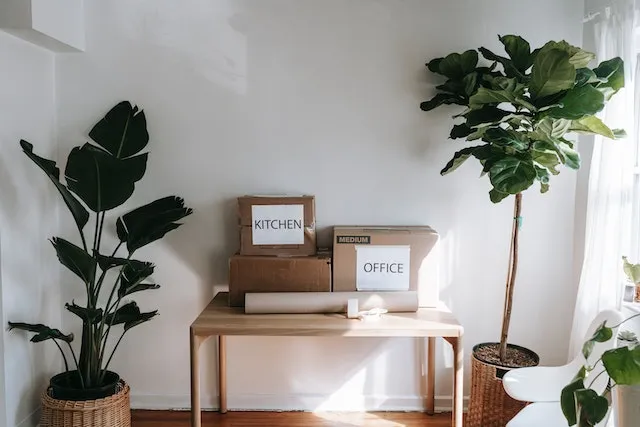In today’s world, being eco-friendly and sustainable is incredibly important in every aspect of life. This also applies to moving, although it’s difficult to make moving completely eco-friendly. Thankfully, by changing only a few things about the process, you can make it much more eco-friendly overall. And while this doesn’t fully prevent damage to the environment, every little bit helps in the long run. So, today we’ll be going over some of the best practices for sustainable moving that will help protect the environment during the moving process.
Use eco-friendly packing materials
The first on the list of best practices for sustainable moving is fairly obvious. Try avoiding the usual packing materials such as plastic and bubble wrap. Instead, consider using biodegradable packing materials, or wrapping your belongings by other means. Biodegradable packing materials shouldn’t be too hard to find, although we should mention they’re typically a bit more expensive. As for alternative packing methods, you can consider wrapping your belongings in towels, clothes, or even magazines. Getting creative like this avoids having to use actual packing materials, which is both cheaper and better for the environment. Even if you weren’t trying to be eco-friendly, this is just a great way to save some money. And you’re trying to move with relative ease, every little thing you can do to make it easier counts. Of course, remember that fragile belongings should still be wrapped properly so they don’t get damaged in transit.
Declutter before the move
Decluttering before you move is a good idea no matter how you look at it. Remember, the less you have to move, the fewer moving supplies you have to use. This results in creating less waste during the process, and even saves you money on packing supplies and moving costs. When decluttering for a move, we recommend using the 1-yeard method. If you haven’t used an item in over a year, get rid of it. Of course, we understand that items can hold sentimental value, but if you haven’t used something in so long at least consider getting rid of it. Decluttering is only one of the steps to secure an eco-friendly transition. But, all in all, it might be the most impactful of the things you can do. This is because most of the impact on the environment is caused by the waste created by packing materials.
Dispose of any chemicals safely
When moving into a new home, you are almost guaranteed to have some chemicals in the old one. No matter how you look at it, moving chemicals is a really bad idea, so disposing of them is the only real option. However, it’s incredibly important to make sure you dispose of these chemicals in a safe manner. The best way to do this and be eco-friendly is to get help from a hazardous waste management company. Whatever the chemicals you need to dispose of are, these professionals will know how to deal with them without impacting the environment. And when planning your move, make sure you know how to make sure the movers are reliable. Having a list of questions to ask potential movers before hiring them is a great idea overall. At the end of the day, you want to make sure you can trust them before hiring them.
Recycle everything you don’t use
As we already mentioned, it’s nearly impossible to move without using any moving supplies. You can supplement it with other things, but certain items will always need to be packed in a specific way. So, when you’re done with your move, make sure to properly recycle the moving supplies you used. By doing this, you avoid the amount of waste created through the move significantly. If you’re unsure how to go about recycling something, you can always ask around at the nearest recycling center. Some recycling centers even offer free pick up of small amounts of materials. And when it comes to the move itself, experts from A2B Moving and Storage recommend measuring the amount of things you plan to move before packing. By doing this, you can avoid buying excess moving supplies and creating more waste than needed. Remember, every little bit counts when trying to be eco-friendly.
Hire an eco-friendly moving company
Another of the best practices for sustainable moving is to rely on eco-friendly movers. In recent times, more and more movers have started going green. These green moving companies will only use eco-friendly materials during the moving process. These include biodegradable packing materials, reusable moving boxes, and so on. All in all, finding a green moving company shouldn’t be too difficult. But, before you decide to hire them, make sure you properly research them. After all, if you’re going to be trusting them to transfer all of your belongings in an eco-friendly manner, you should make sure they are actually reliable. And when you’re in your new home, if it’s your first time being a homeowner, make sure you know how to maintain your home. After all, home maintenance can be overwhelming if you’re new to it, so knowing what you’re getting into can help a lot.
Donate or sell what you don’t need
We already mentioned that decluttering is very important when moving in an eco-friendly way. However, you shouldn’t just throw away the things you don’t need, as this creates waste. Instead, consider donating the items to someone else. Or, if you want to make up for some moving costs, selling these items is also a good idea. The only thing that’s important is that you don’t create any more waste than is necessary.
Sustainable design and building relocation: best practices for sustainable moving
Unfortunately, it’s almost impossible to move without impacting the environment in some way. But there are things you can do to minimize the effect of your move on the environment. As long as you’re smart about it, you can still realistically move in an eco-friendly way. We hope this list of the best practices for sustainable moving helps you out, and we wish you luck with your move.





